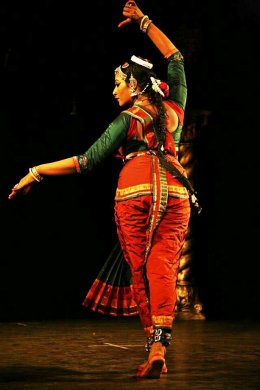 |
|
 |
|
The flavour of Vazhuvoor - Satish Suri e-mail: satishism@yahoo.co.in April 19, 2014  Nattuvanars or members of their family performing on stage are rare.
With a historic lineage and credentials that merit more than a mention,
Nrithya Pillai, great granddaughter of Vazhuvoor Ramiah Pillai and
granddaughter of Swamimalai S.K. Rajarathnam Pillai, gave a solo
performance under the auspices of Sai Arts International at Seva Sadan
on 30th March. The performance began with an ode to Nataraja, “Kapali ni
dayanidhi.” Skillfully tweaked into the piece was the Tisra
Alarippu adding imagery to the choreography. The attributes of the lord,
his garment made out of tiger skin, the churning of the ocean of milk,
and the poison that emerges being swallowed by the lord earning him the
name Neelakanta were depicted with perfection and grace. Nattuvanars or members of their family performing on stage are rare.
With a historic lineage and credentials that merit more than a mention,
Nrithya Pillai, great granddaughter of Vazhuvoor Ramiah Pillai and
granddaughter of Swamimalai S.K. Rajarathnam Pillai, gave a solo
performance under the auspices of Sai Arts International at Seva Sadan
on 30th March. The performance began with an ode to Nataraja, “Kapali ni
dayanidhi.” Skillfully tweaked into the piece was the Tisra
Alarippu adding imagery to the choreography. The attributes of the lord,
his garment made out of tiger skin, the churning of the ocean of milk,
and the poison that emerges being swallowed by the lord earning him the
name Neelakanta were depicted with perfection and grace. The hallmark of her presentation was the varnam “Samiyai Azaithuvadi’ on Madurapuri Sundaresha in adi tala and raga Khamas composed by Ponnayya Pillai. It was punctuated with vibrant jathis, crisp neat lines and imaginative choreography highlighting the glorious tradition of the Vazhuvoor bani. Her dexterity of footwork and beautifully rendered jathis characterised the presentation. The nayika pleads with the sakhi to bring Lord Sundaresha of Madurai to her as she is longing for him. The description of the lord clad in tiger skins, with snakes as his ornaments, her despair, the torment of Manmatha’s arrows and the agony to unite with him bore testimony to the artist’s expressive skills and adherence to tradition. The exploration of the many facets of this composition, the sensuous and graceful movements added verve and vibrancy to her presentation with the sakhi finally leaving with the message to be given to her lord. The next piece, a Purandaradasa composition “Innudaya barade” depicted the pitfalls of ego and desires of material possessions that finally bring an individual to surrender to the mercy of the divine. The artist’s sensitive abhinaya exploring the gamut of emotions was meaningful. The javali “Sako ninna sneha” portrays a khandhita nayika disillusioned with her wayward lover who has gone to be with the other woman. Determined and firm in her accusations, she finally shows him the door, though deep within she feels a sense of remorse when he finally leaves. Evocative expressions characterised this presentation. The finale was provided by a scintillating tillana in Surutti, a composition by Samu Nattuvannar in praise of Chamarajendra Wodeyar replete with impressive display of dexterity of movement and sculptural poses. The whole performance pulsated to the rhythm of the soundscape with excellent vocal support by Roshni Ganesh, nattuvangam by Jayakamala Pandiyan complimented by Narayanaswamy on the mridangam, Mahesh Swamy on the flute and Nataraj Murthy on the violin. Padmini Ramachandran, the noted guru of the Vazhuvoor bani, remarked that the great value attached to the Vazhuvoor style was to allow the artist to feel and be one with the item being presented. Nrithya Pillai with her dedication and commitment may soon be one more jewel in the crown of the Vazhuvoor casket. Satish Suri has been an ardent follower of dance and music for more than 40 years, starting with being on the committee of the International Music and Arts Society founded by Vijaya Devi, sister of the Late Maharaja of Mysore, Jayachamarajendra Wodeyar and now presently is treasurer of World Dance Alliance Karnataka Chapter. He has presented several artistes, both dancers and musicians, over the last 4 decades. |